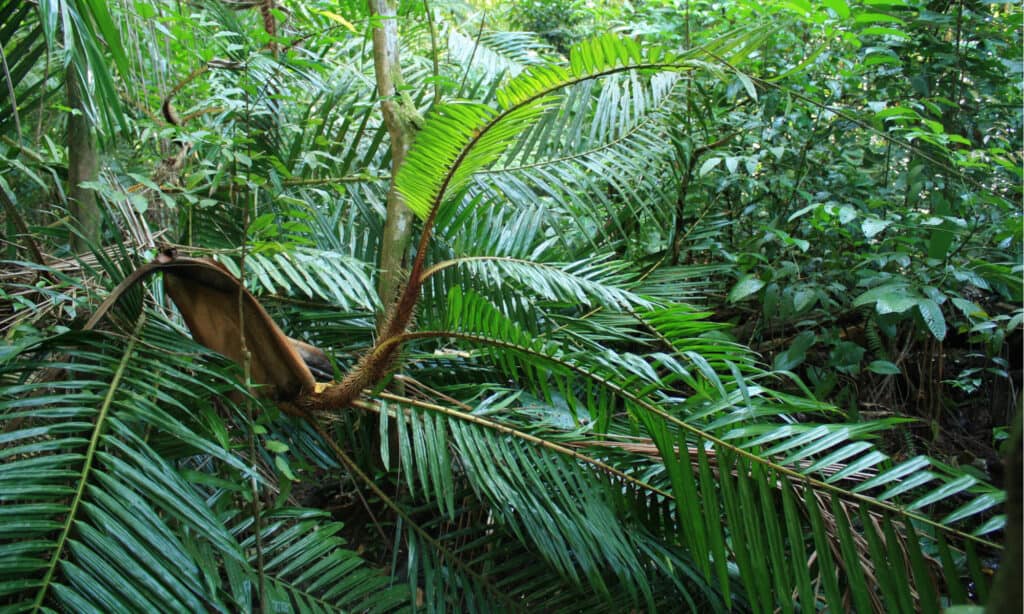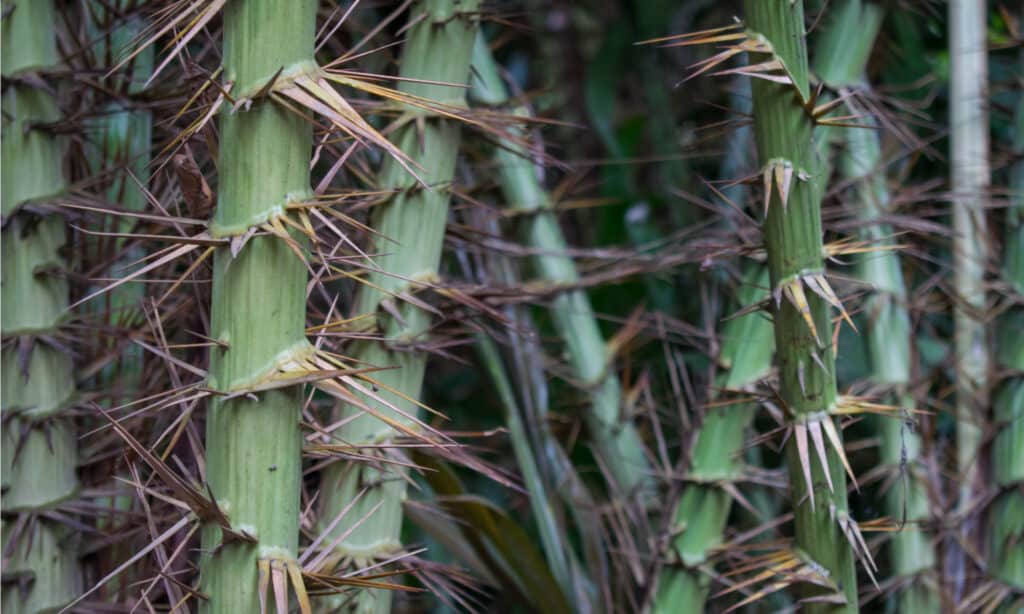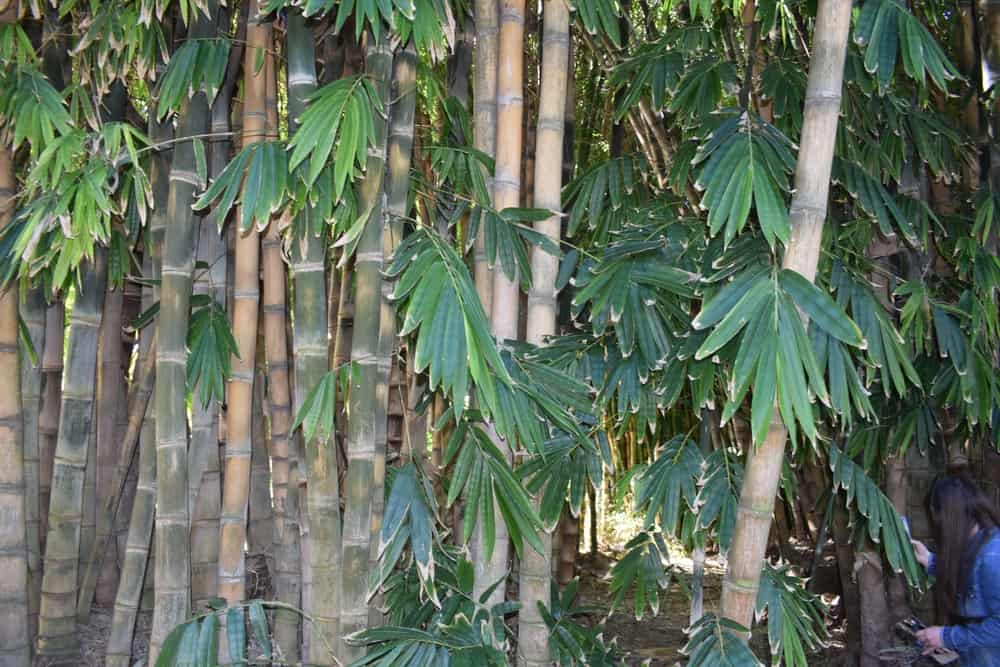While these materials may look similar as finished products, there are a number of differences between rattan vs bamboo. Both of these plants are utilized around the world, in a number of applications, but what makes them special, and how do they compare to one another? If you’re eager to learn more about bamboo and rattan, you’re in the right place!
In this article, we will compare and contrast bamboo and rattan so that you can gain a full understanding of both of these fantastic plants. We will go over what they look like as well as what they are typically used for. Finally, we will address where these two distinct plant species grow best and how you can grow your own. Let’s get started.
Comparing Rattan vs Bamboo

| Rattan | Bamboo | |
|---|---|---|
| Classification | Calamoideae | Poaceae bambusoideae |
| Description | A variety of vining palm with spines on its trunk and large, unique leaves. Often grows clustered with other rattan plants, and forms spiky fruits upon maturity. Leaves resemble those found on palm trees; this plant does not branch. | Thin, woody trunks that end in long and delicate leaves. Can grow up to 90-100 feet tall, depending on the species, of which there are roughly 1200! Comes in a variety of colors, including green, gray, black, and red. Stems or trunks are typically hollow, with visible rings around the outside to show their growth. |
| Uses | Dozens of uses, specifically intricate furniture. More flexible than bamboo, and some species are used in culinary applications as well. Popular in basket and rug making as well as building. | Dozens of uses, including furniture, paper crafts, culinary applications, home building, accessories, home goods, decoration, and more. Also utilized medicinally in many cultures, and you can make musical instruments too! |
| Hardiness Zones | 10-12 | 5-10 |
| Water and Light Needs | Enjoys well-drained soil and often grows in shady regions of forests, underneath other trees and plants. Does like some sunlight too. | Depends on the species, but often needs at least 5 hours of bright, indirect light per day. Needs an inch or two of water per week, but don’t let the roots sit in water. |
Key Differences Between Rattan vs Bamboo

Rattan belongs to the palm family, while bamboo belongs to the grass family.
©WOODKUKA BORNEO/Shutterstock.com
There are a number of key differences between rattan and bamboo. These plants are from very different families from one another, with rattan belonging to the calamoideae family and bamboo belonging to the poaceae family. In addition, rattan is primarily a vining plant, while bamboo forms rigid poles. Finally, rattan is solid and more flexible compared to the hollow and structured bamboo plant.
Let’s go over all of these differences in more detail now.
Rattan vs Bamboo: Classification
Even though they may have extremely similar uses, bamboo and rattan belong to very different plant families. For example, rattan belongs to the palm family, while bamboo belongs to the grass family. The scientific names for both of these plant families are calamoideae and poaceae respectively. There are even certain varieties of rattan and bamboo that grow in a similar clustered fashion, but they are indeed very different plants.
Rattan vs Bamboo: Description

Bamboo comes in sections, with distinct rings showing their age along the trunks, while rattan is often covered in dangerous looking spikes, depending on the species.
©Eric Patterson/Shutterstock.com
One of the key differences in the overall description of bamboo and rattan has to be the fact that rattan is primarily a vining plant, while bamboo is a rigid plant. In addition, the leaves of the rattan plant are strikingly similar to palm tree leaves, while bamboo has unique and delicate leaves. Both rattan and bamboo plants come in a variety of colors, but one of the primary differences between them is the fact that bamboo is hollow and rattan is not.
You likely know that bamboo comes in sections, with distinct rings showing their age along the trunks, while rattan is often covered in dangerous looking spikes, depending on the species. Rattan plants also produce edible fruits, while bamboo does not do this. Finally, while it is unclear just how high rattan can climb, most bamboo plants grow taller than rattan does.
Rattan vs Bamboo: Uses

Given the flexible nature of rattan, it is used in a more intricate application more often than bamboo is, as it is easier to work with if you are making something with curves or weaving.
©Peerapat Saoraso/Shutterstock.com
One of the main similarities between bamboo and rattan has to be their overall uses. Both of these plant products are utilized in a variety of industries, including papermaking, furniture crafting, and home building or manufacturing. However, given the flexible nature of rattan, it is used in a more intricate application more often than bamboo is, as it is easier to work with if you are making something with curves or weaving.
Bamboo is arguably used more often than rattan is, but they are both extremely useful plants in a variety of fields. There are even culinary varieties of both plants, though bamboo is typically cooked more frequently than rattan. No matter what, both of these plants offer a more sustainable option for us, especially when it comes to building materials.
Rattan vs Bamboo: Hardiness Zones
If you are interested in growing either rattan and bamboo in your own backyard, there are some important things to note about where they grow best. Depending on the species of either plant, most bamboo grows in more hardiness zones compared to rattan. For example, most rattan varieties must be grown in the tropical regions of 10 to 12, while some cold tolerant species of bamboo grow well in regions 5 through 10.

Depending on the species of either plant, most bamboo grows in more hardiness zones compared to rattan.
©Furiarossa/Shutterstock.com
Rattan vs Bamboo: Water and Light Needs
A final difference between rattan and bamboo is their plant care needs. Bamboo enjoys a decent amount of direct sunlight per day, while rattan thrives in a shady environment, much like the undergrowth it naturally lives in. Both of these plants prefer well-draining soil and don’t want to be left in water, though some species of bamboo don’t mind a bit more moisture compared to rattan.
The photo featured at the top of this post is © WOODKUKA BORNEO/Shutterstock.com
Thank you for reading! Have some feedback for us? Contact the AZ Animals editorial team.







